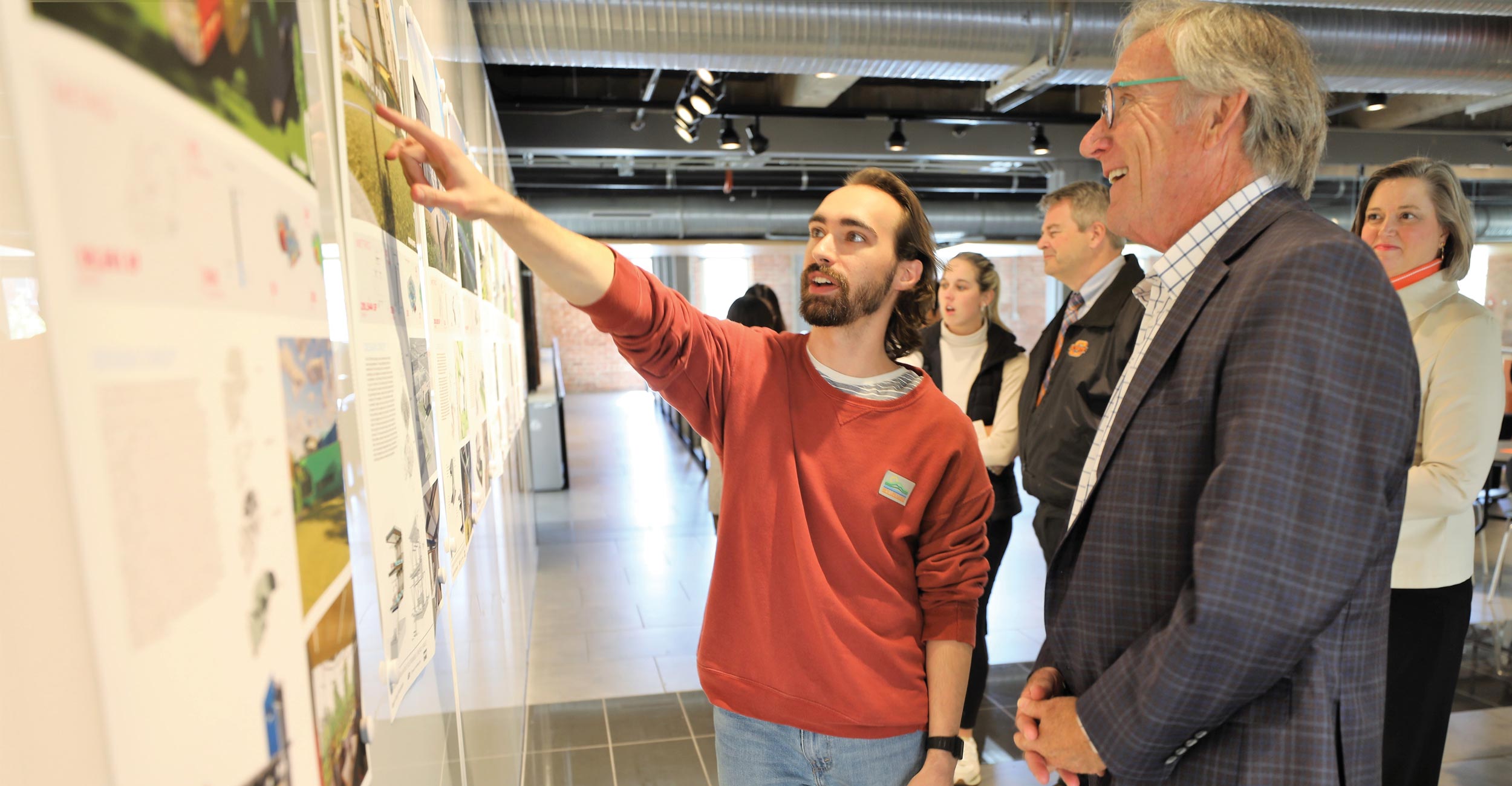
Architecture students learn about sustainable design in comprehensive studio
Monday, September 25, 2023
Media Contact: Kristi Wheeler | Manager, CEAT Marketing and Communications | 405-744-5831 | kristi.wheeler@okstate.edu
Oklahoma State University’s School of Architecture “RAISED” the bar by promoting sustainability and preparing students professionally through the 2022 Comprehensive Studio.
The 2022 Comprehensive Studio received financial support from the Renewable and Innovative Sustainable Energy (RAISE) initiative, which is offered by the School of Electrical and Computer Engineering (ECE) through support from the Martin Family Foundation.
The RAISE grants awarded architecture students for designing sustainable buildings for their studio projects. Dr. Khaled Mansy and professor Keith Peiffer, along with colleagues Dr. Tom Spector and John Phillips, worked with students through the process and evaluated their work.
Mansy, professor of architectural engineering, saw the opportunity for RAISE grants to support the Comprehensive Studio, a learning experience that blends building performance and architecture together through collaboration.
Through project-based learning, senior architecture and architectural engineering students work together to focus on systems integration. They start designing at a higher complexity than previous studios by determining appropriate sizes and components for the structural and mechanical systems before incorporating them with their other aesthetic and functional goals for the project.
The spring 2022 studio students created designs for a prototypical classroom facility for Science, Technology, Engineering, Arts and Mathematics (STEAM) Engine OKC. This nonprofit organization was created by Morgan Robberson Jones, a 2012 graduate of the School of Architecture. The organization intends to teach children ages 8-13 by building on traditional education with 21st century skills emphasizing STEAM disciplines. The studio students were instructed to design a building that would help enrich the students’ education in these areas.
Comprehensive Studio also prepares students professionally by making them aware of current trends and predicted changes in their career fields.
According to a 2021 study by the Lawrence Livermore National Laboratory, residential and commercial buildings consume around 40% of the energy and 74% of the electricity in the United States. This reality led the American Institute of Architects to collaborate with Architecture 2030, a nonprofit organization, to set energy use intensity (EUI) target values per building type to reduce energy consumption significantly by 2030.
While following these practices isn’t mandatory in professional practice, Mansy set the performance goal of meeting the 2022 target EUI in the Comprehensive Design studio. For the faculty in the School of Architecture, designing to reduce energy consumption is a necessary aspect of effective design.
“We want to make sure we understand what’s happening in the profession and future transformations,” Mansy said. “One way to do so is to use targets established by the profession for the energy industry. We want students to understand these practices and start to think about how they can design buildings to try to meet them; that takes a certain expertise and awareness.”
The RAISE initiative was supported by the Martin Family Foundation and sponsored by ECE and the Comprehensive Design Studio. RAISE funds were used to reward students whose projects exceeded the measurable goals set for sustainability and building performance. The awards totaled $4,500 and were given in four categories: Most Efficient Building, Highest Energy Savings by Design, Closest to Net Zero Energy and Best Use of Daylight.
RAISE recipient Brandon Davis designed his building’s heating, ventilation and air conditioning (HVAC) systems to be efficient and educational. His structure featured an exposed HVAC system that was color-coded so students could associate colors with different things like water lines and supply ducts. He also included a glass wall in the mechanical chases of the building so students could see how the building systems interacted between floors.
“For me, the project was interesting because I like the connection to sustainability, and nature in itself is important to me,” Davis said. “It was pretty seamless to consider the impact on the environment whenever we were designing the building. The RAISE Award was also an extra motivation.”
Third-place recipient in the best use of daylight category, Gustavo Villegas, worked hands-on with Mansy to create an optimal condition for the project. He looked at ways to reduce heating and cooling loads, take advantage of the position of the sun and bring more daylight into the space.
“I think the most important thing I took away from the project was to set a goal for sustainability very early on in the design process so that it can influence all of the decisions that come after,” Villegas said.
Peiffer, assistant professor of architecture, and his teaching assistant, Whitney Waitsman, created posters with drawings, renderings and performance data of the student design proposals, as well as information on the studio and RAISE award categories. The posters were exhibited in Oklahoma City and Tulsa to raise public awareness.
“In the School of Architecture, we want to share our students’ work with a broader audience. We understand the significance of design in reducing energy consumption, but not everyone in Oklahoma does. We want to find ways to make this information accessible and help people understand the incredible potential for performance-based design.”
Collaboration, presenting to the public and receiving hands-on experience are only a few examples of how the Comprehensive Studio prepares students for the professional world.
“I think that it’s just nice to show the community that we are thinking about it,” Davis said. “These cool designs have really high sustainability aspects to them to make our future better. Students are learning to consider the world, not just a building as an object.”
Photos: Kristi Wheeler
Story by: Bailey Sisk | IMPACT Magazine
